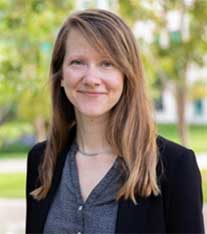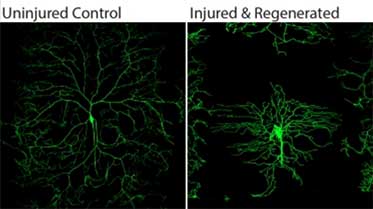Katie Thompson-Peer highlighted by The Scientist as one of ten rising stars in neuroscience

Nervous systems are comprised of individual nerve cells, AKA neurons, that communicate with each other in circuits. Neurons have an architecture that resembles a tree: they have a highly branched arbor and a single long trunk that splits into roots. The branches of the arbor are called dendrites, and the single long trunk is the axon. Dendrites act as the antennae for the neuron: they allow it to receive information. The axon allows the nerve cell to send signals to other neuron or muscle cells that may be far away. Input through the dendrite arbor antennae, output through the axon to the target cells.
When Dr. Katherine Thompson-Peer, PhD, a new fellow of the RIRC, began her work as a postdoctoral fellow with Dr. Yuh-Nung Jan, PhD, at UCSF and the Howard Hughes Medical Institute, she realized that although scientists have considerable insights into when neurons can or cannot regenerate axons after injury, extremely little is known about how nerve cells respond to injury to their dendrites. For a tree, a trunk is necessary fora tree to survive, and damage to the trunk can be fatal – but it is equally true that branches and leaves are necessary for the tree to survive. What happens when dendrites are injured as can occur with trauma in either brain or spinal cord? Could a neuron regenerate dendrites after injury? If so, would the regenerated dendrite look like an uninjured neuron, or would it have the scars from injury?
Presumably, the reason why this fundamental question had been so little examined previously by scientists is because it is hard to selectively injure dendrites using traditional surgical techniques in rodent experiments. So Dr. Thompson-Peer took a different approach. Instead of using surgery, she developed a technique using lasers, that would allow her to very precisely injure individual branches of the neuron’s dendrite arbor. She also adapted a model system that would allow her to follow the response to injury in individual neurons over time, so that she could longitudinally track how each neuron responded day by day to the injury. The model system is the beautiful net of sensory neurons in the skin of developing Drosophila (fruit fly).

Dr. Thompson-Peer discovered that soon after amputating a dendrite, sensory neurons initiated a growth response leading to dendritic regeneration. Interestingly, she also discovered that neurons regenerated the normal number of branches, but the branches appeared stunted, in the same way that a tree regrows shorter branches after pruning a “runner”. But, just like a tree that has regrown after pruning, the arbor didn’t look like an uninjured neuron. The other really interesting discovery is that regenerating dendrites ignored cues in the environment that normally determine where branching occurs.
Regenerated dendrites were thinner, and the whole arbor was smaller and denser than an uninjured neuron. As a consequence, while the regenerated dendrites restored receptive function to the neuron, they only partially restored what had been lost (sounds a lot like axon regeneration failure). The neurons could receive information, but only about half as well as a normal neuron.
In her new lab at UC Irvine, as part of the RIRC, Dr. Thompson-Peer will be teasing apart the cellular mechanisms that allow neurons to regenerate dendrites and interrogating the factors that limit regeneration. What manipulations will allow neurons to regenerate dendrites more effectively?
And, more broadly, are there circumstances or injuries or neuron types that are incapable of regenerating dendrites? Leveraging her training in neuronal development from the University of Pennsylvania, JohnsHopkins Medical School, and Harvard Medical School, bringing the tools to study dendrite regeneration that she developed as a postdoctoral fellow at UCSF, and funded by grants from the National Institute ofNeurological Disorders and Stroke, Dr. Thompson-Peer is building a research lab to make significant advancements in this field. By addressing fundamental questions about dendrite regeneration, Dr.Thompson-Peer and colleagues hope to advance our understanding of how neurons can regenerate these essential cellular structures.
We’re very excited to also announce that just before press time for this newsletter, the journal The Scientist highlighted Katie Thompson-Peer as one-of-ten rising stars in neuroscience.
Congratulations Katie!






